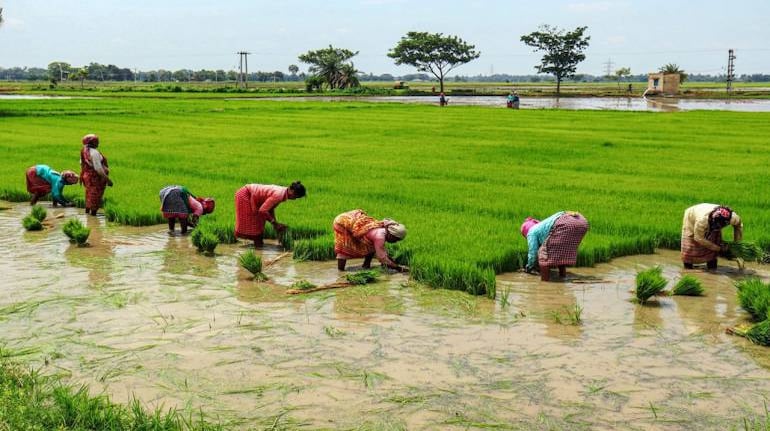



COVID-19 has created an extraordinary situation where both demand and supply curves have been deeply supressed simultaneously. The economy contracted by 23.9 percent in the quarter ending June. The agriculture sector stood-out as an exception which grew by 3.4 percent during the same period. While agriculture can be at the core of revival, economic growth needs to be propelled by the overall rural economy.
Importance Of FPOs
Agriculture output and farm-level income are expected to grow by 5-10 percent during this financial year. The positive sentiments are already reflecting in higher demand for tractors and stock prices of agriculture value chain driven institutions. To drive agriculture growth, Farmer Producer Organisations (FPOs) needs to be made the fulcrum of the developmental activities.
Crop cluster development programmes in Haryana and Mission Organic Value Chain Development for the North Eastern Regions have shown that active participation of the FPOs helped in accessing inputs, developing market linkages for produce, and have the potential to bring processing facilities closer to farms. The idea of ‘Smart Farming’, initiated by Rajasthan in 2016, which was focused on bringing convergence of various schemes to farmers, may be customised to bring the benefits to small and marginal farmers through the FPOs.
The larger play by the FPOs will also catalyse private investors in the value chain and the ecosystem. These measures would support higher income for the farmers, spur vertical integration of players, and attract organised private players to the sector. Additionally, the FPO driven gradual shift towards high value crops in certain regions may be considered.
Early Intervention For Rural Sector
The rural sector has its own set of challenges, which include suppression of rural wages owing to the reverse migration of labours, channelising credit to the agriculture sector (95 percent of which is provided by banks), and the on-going shift of the services sector and value additions (manufacturing) to urban areas. These events have accentuated issues that need immediate redress both from supply-side and demand-side.
The three agriculture reform ordinances passed in May, which recently became law, and the stimulus packages such as Agri Infrastructure Fund, Micro Food Enterprises, PMMSY Fund, among others, would largely stabilise the supply-side and keep food inflation in control.
Similarly, from the demand-side, direct benefit transfer to various beneficiary groups and work opportunities under multiple programmes are applaudable initiatives. However, these may not be sufficient to stimulate demand immediately. The DBT under PM-KISAN (for farmers having less than two hectares) may be increased to Rs 10,000 for this financial year to push the discretionary expenditure during the upcoming festive season. Additionally, the opportunity should be used to phase out indirect subsidies with the DBT.
Non-Agricultural Measures
On the backdrop of the ‘vocal for local’, districts or clusters can be targeted for promotion of industries, particularly the labour-intensive MSMEs, as well as low-capital entrepreneurial cooperatives for promoting handicrafts, local artefacts, supplies for seasonal celebrations, etc. In order to make these initiatives successful, infrastructure requires significant thrust, be it ICT, investments in market infrastructure, storage (including temperature-controlled) linked or logistics infrastructure.
Development of rural roads under the PMGSY-III should be accelerated further to harness the growth potential of rural areas. Special attention is required on rural health infrastructure, which faces acute pressure due to the pandemic and reverse migration.
Technology can be the game changer to transform rural health infrastructure. Tele-medicine, tele-radiology, tele-ICU, and e-pharmacy, etc. can also play a critical role. For meeting human resource requirements in the health sector, capacity building using digital platforms as well as enhancing the roles of primary caregivers through up-skilling should be considered. Last but not the least, the focus has to be on encouraging circular economy for long-term sustainability.
Financing Initiatives
The required fund to promote these agriculture and non-agricultural measures could come from the convergence of various schemes including the stimulus packages, unlocking special funds like district mineral fund (DMF), savings from current account deficit, and money financing.
All-in-all, it is expected that the revival shall be led by rural sector demand for tractors, staples, irrigation equipment, agri inputs, and health- and hygiene-related products and services. Focused interventions on increasing demand would ensure a quicker recovery by fuelling discretionary expenditure in the near term.
Satyam Shivam Sundaram is Partner, Government and Public Sector, EY India. Views are personal.
Discover the latest Business News, Sensex, and Nifty updates. Obtain Personal Finance insights, tax queries, and expert opinions on Moneycontrol or download the Moneycontrol App to stay updated!
Find the best of Al News in one place, specially curated for you every weekend.
Stay on top of the latest tech trends and biggest startup news.